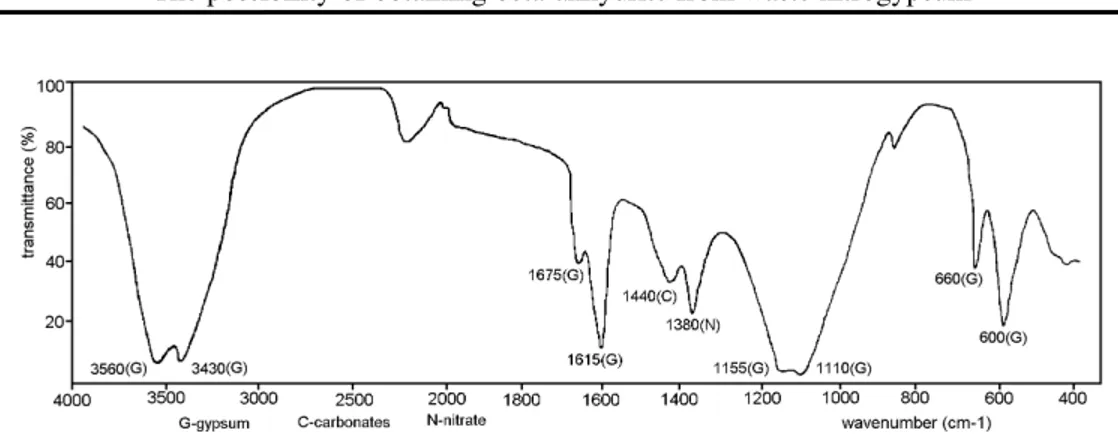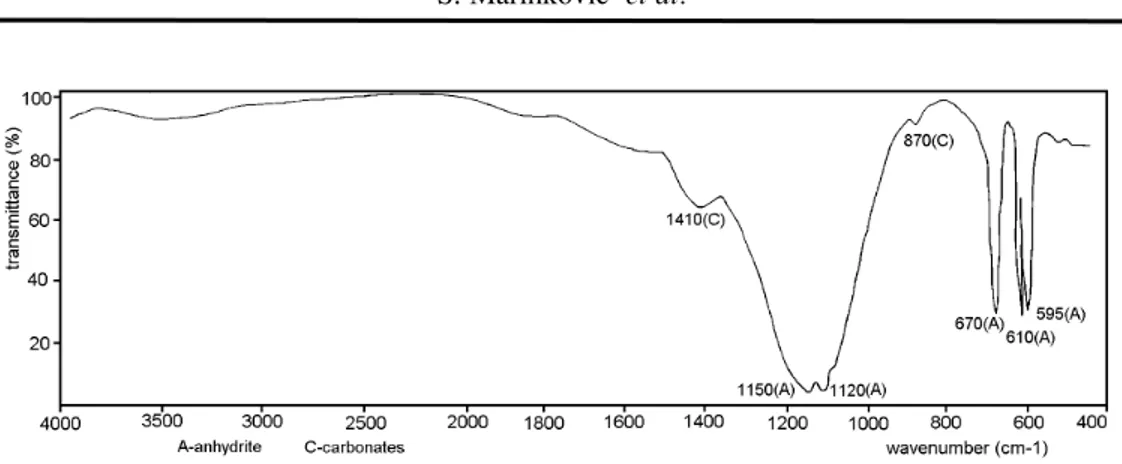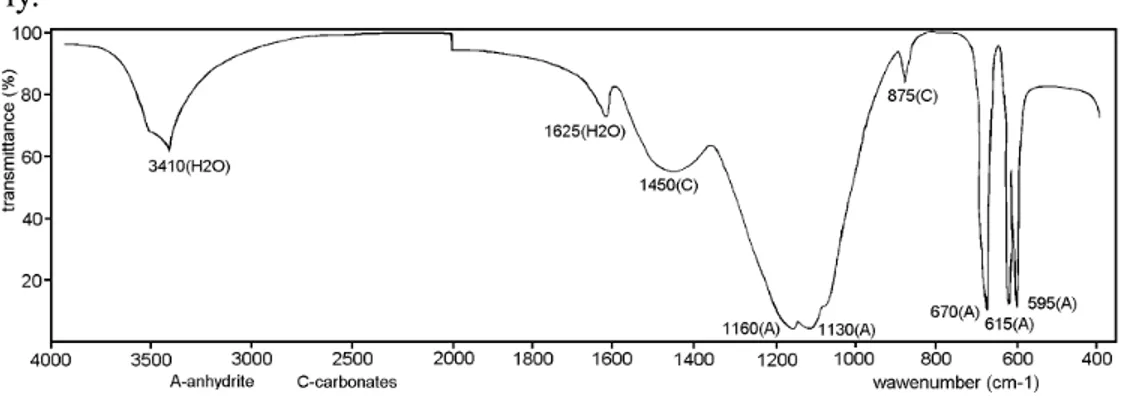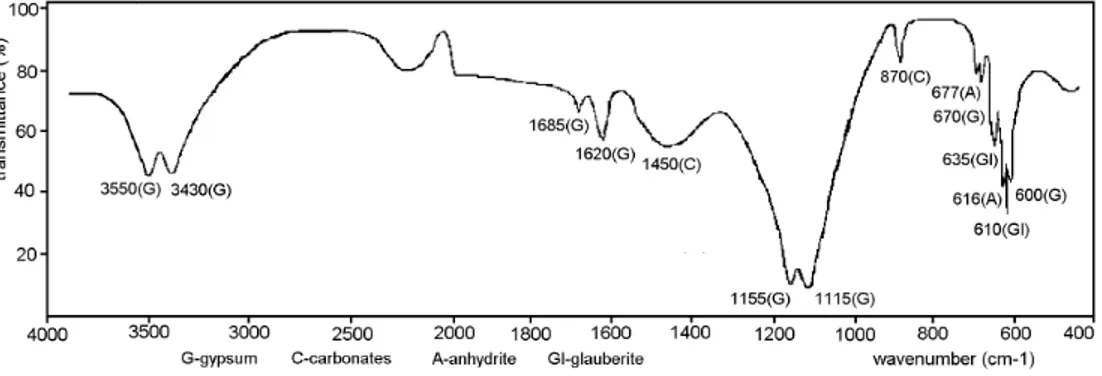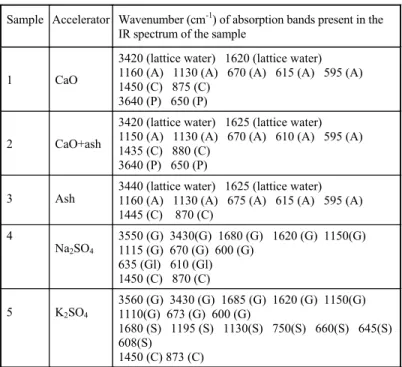THE POSSIBILITY OF OBTAINING
BETA-ANHYDRITE FROM WASTE
NITROGYPSUM
S. Marinkovi}#
, A. Kosti}-Pulek, S. Popov, J. Djinovi}and P. Trifunovi}
University of Belgrade, Faculty of Mining and Geology, Djusina 7, 11000 Belgrade, Serbia and Montenegro
(Received 25 December 2003, accepted 12 April 2004)
Abstract
The possibility of obtaining β- anhydrite from nitrogypsum, which is waste from a nitro-cellulose plant, was investigated. It was shown by means of qualitative IR analysis that the product obtained by heating nitrogypsum for 5 hours at 700 o C was â - anhydrite. When the
β- anhydrite was mixed with water at a W/S (water/solid) ratio of 0.54 in presence of different accelerators (CaO, mixture CaO - ash, ash, Na2SO4and K2SO4), pastes were formed which
hardened on standing. The compressive strength of the hardened samples was measured after 7 and 28 days and their composition determined by qualitative IR analysis. On the basis of these results, it was observed that a relationship exists between the composition (depending on the used accelerator) and the compression strength of the samples. Namely, the formation of large cores of double salts: syngenite (K2SO4⋅CaSO4⋅H2O) and glauberite (Na2SO4⋅CaSO4),
in the presence of the accelerators K2SO4and Na2SO4, respectively, was due to the rapid and
complete crystallization of the dihydrate (CaSO4⋅2H2O). This fast crystal growth of the
dihydrate resulted in high compressive strengths of these samples. In the other samples (prepared in presence of the accelerators: CaO, mixture CaO – ash and ash), dihydrate did not form and, consequently, their compressive strength was low.
Keywords:gypsum, nitrogypsum, β-anhydrite, syngenite, glauberite
1. Introduction
β-Anhydrite, or anhydrite (II), is a rhombic modification of CaSO4 which does not dissolve in water and virtually does not react with it [1, 2]. However, in the presence of certain accelerators (Na2SO4, K2SO4, CuSO4, CaO, ash, etc.), β-anhydrite mixed with water forms CaSO4⋅2H2O and hardens and can be used as a binder (anhydrite cement) in the building industry [3, 4]. The effect of various accelerators on the setting and hardening of anhydrite and the properties of anhydrite cement have been studied [5, 6, 7], but the available data are not sufficient to explain the exact behaviour of the accelerators on the setting and strength development of anhydrite cement. Therefore, the choice of an accelerator is usually made experimentally [8].
β-Anhydrite is usually the dry-process product of heating natural or so-called waste gypsum at 450 to 750 o C [3, 4, 9]. The utilization of waste
gypsum, as a raw material, in the manufacture of useful building materials (hemihydrate, anhydrite) has recently become very interesting not only from the point of view of solving environmental problems, but also for economic reasons. It is always preferable to utilize waste than to deposit it. Besides, waste gypsum utilization is interesting because the reserves of natural gypsum are depleted in many countries of the world (also in our country). The question of whether waste gypsum, containing specific impurities, can substitute natural gypsum is a much studied issue at present, because the type and amount of impurities included in the products (hemihydrate, anhydrite) influence the mechanical properties of binders. Earlier literature data [4] suggested that the products from waste gypsum were of poorer quality. However, new literature data [8, 10] show that products from waste gypsum can be of quite satisfactory quality.
Waste gypsum is a by - product in the manufacture of some acids (phosphoric, boric, citric, etc,), a product in the flue gas desulphurisation (FGD) processes in coal-based power stations, as well as a product of the neu-tralization of sulphuric acid, present in the waste water of many industrial processes. So-called nitrogypsum is formed by the neutralization of wastewater from nitrocellulose plants, according to:
The possibility of applying nitrogypsum as a raw material for obtaining β -anhydrite, useful for the construction industry, was investigated in this study. CaO, ash-CaO mixture, ash, Na2SO4and K2SO4were used as accelerators.
2. Experimental
Nitrogypsum waste from a nitrocellulose plant (Serbia), as a potential raw material for β-anhydrite production, was examined in order to determine its chemical composition and some physical properties (the shape and size of its crystals). The chemical composition of wet nitrogypsum was determined by quantitative chemical analysis. Also, nitrogypsum was subjected to qualitative infrared (IR) analysis. The IR spectrum was recorded on a Perkin Elmer Spectrophotometer 782, in the range 4000 to 400 cm-1, using the KBr pellet
technique (the same spectrophotometer and the same technique were also used to record all the other IR spectra in this study). The shape and size of the nitrogypsum crystals were determined by observing the crystals under an American Optical Spectroscope ZOOM microscope.
The chemical composition of ash was determined by quantitative chemical analysis and its phase composition by X-ray powder diffraction technique, using a Philips PW 1729 X-ray generator and a Philips PW 1710 diffractome-ter. The radiation source was an X-ray LLF tube with copper radiation and a graphite monochromator. The radiation was λCuKα1= 0.15405 nm. The anode tube load was 40 kV and 35 mA. The sample was examined in the 2 θ range from 5 to 60 o. The X-ray results were interpreted using JCPDS cards.
In order to obtain β-anhydrite, the untreated nitrogypsum (no grinding, drying or washing) was heated in a laboratory electric oven at 700 oC. The
dehydration was monitored by qualitative IR analysis in order to determine the shortest time necessary for the conversion of gypsum (CaSO4⋅2H2O) to β -anhydrite (CaSO4). The IR spectra of samples taken in 30 min intervals from the oven during the treatment were recorded. The disappearance of bands in the spectra corresponding to crystal water was used to determine the time required for the transformation of nitrogypsum into β-anhydrite.
The amount of accelerator was 2 mass % of the amount of anhydrite. The water content in the mixture (paste) was 35 % and hence the water/solid ratio (W/S, volume or mass of water to the mass of β-anhydrite and accelerator) was 0.54.
The samples were tested for compressive strength after 7 and 28 days. These strengths were compared with GOST 2767-44 standard compressive strength values [3]. Also, these samples, after 7 and 28 days of hardening, were pulverized and qualitative IR analyzed for their composition.
3. Results and discussion
The chemical analysis of the wet nitrogypsum is given in Table 1.
The above results show that there was a considerable amount of absorbed water in the wet nitrogypsum, as well as some amounts of CO2 and nitrates. The carbon (IV) oxide indicates the presence of carbonates as impurities, beside nitrates, in the wet nitrogypsum. The IR spectrum of the nitrogypsum (dried at 40 oC) is presented in Fig.1.
The spectrum (Fig.1) contains absorption bands which are characteristic of CaSO4⋅2H2O [11, 12, 13]. Beside these bands, the IR spectrum contains absorption bands at 1440 and 1380 cm-1, which confirm the presence of some
carbonates and nitrates, respectively, [13] as impurities, in the nitrogypsum. These results are in accordance with the chemical analysis of the nitrogypsum (Table 1.)
Microscopic analysis showed that the nitrogypsum was composed of tabular microcrystal aggregates (size 11-17 µm), as well as needle-like monocrystales (size 8-12 µm), and that it could be used without preliminary grinding (being powdery) for β-anhydrite production.
Component (mass. %)
Absorbed
water H2O(crystal.) CaO SO3 MgO NO3
-CO2 Organic
matter
Insol. matter 27.91 14.10 23.77 30.40 0.57 0.99 1.87 0.11 1.03
The chemical analysis of the ash is given in Table 2.
The results of X-ray examination of the ash indicate that the main phase of this material was quartz (d – 0.427, 0.335, 0.246, 0.229, 0,213, 0,203). Other phases were: anhydrite (d – 0.350, 0.285, 0.220), α-hematite (d – 0.270, 0.252, 0.182) and unbound CaO (d – 0.278, 0.240, 0.170).
The IR spectrum of the product obtained by heating the nitrogypum for 5 hours at 700°C (Fig. 2.) does not include bands characteristic of crystal water (at 3560, 3430, 1675 and 1615 cm-1, seen in Fig. 1.), but only the bands
char-acteristic of insoluble anhydrite, e.g. β-anhydrite [11, 13]. In this spectrum there is a band at 1440 cm-1, which confirms that carbonates (impurities) did
not disappear during nitrogypsum heating at 700 oC. However, there is no a
band at 1380 cm-1which corresponds to nitrates (see Fig. 1.), indicating nitrate
decomposition during heating.
Fig. 1. IR spectrum of nitrogypsum
Component (mass. %)
SiO2 Al2O3 Fe2O3 CaO MgO Na2O K2O TiO2 P2O5 SO3 Loss of
ignition
37.16 15.12 8.58 17.95 2.90 0.19 0.83 1.00 0.067 2.85 13.35
The compressive test results for samples (W/S = 0.54) prepared in the presence of different accelerators, after 7 and 28 days, are given in Table 3.
The results in Table 3 show that the samples prepared from the β-anhydrite in presence of Na2SO4 and K2SO4 possess compressive strengths (after both 7 and 28 days) higher than the lowest GOST 2767-44 standard values (7-11 MPa after 7 days and 10-20 MPa after 28 days). The samples prepared from the β-anhydrite in the presence of the other accelerators CaO, CaO - ash and ash, were not resistant enough to compression, neither after 7 nor after 28 days.
The IR spectra of pulverized samples prepared by mixing the β-anhydrite with water in the presence of different accelerators CaO, mixture CaO - ash,
Fig. 2. IR spectrum of product obtained from nitrogypsum after 5 hours
Table 3. Comperessive strengths of hardened samples
Sample Accelerator Compressive strenght, MPa
After 7 days After 28 days
1 CaO 0.52 1.86
2 CaO-ash 0.55 1.80
3 ash 1.07 1.99
4 Na2SO4 8.45 12.14
ash, Na2SO4and K2SO4, after 7 days are presented in Figures 3-7, respective-ly.
Fig. 3. IR spectrum of sample prepared by mixing β-anhydrite with water in presence of CaO
Fig. 4. IR spectrum of sample prepared by mixing β-anhydrite with water in presence of mixture CaO - ash
The IR spectra of the powdered samples obtained by mixing β-anhydrite with water in presence of the accelerators CaO, mixture CaO - ash and ash (Fig. 3., 4. and 5.) after 7 days, are almost identical. These spectra do not exhibit bands characteristic of water in CaSO4⋅2H2O, but medium bands at about 3400 cm-1( 3410 cm-1 in Fig. 3., 3420 cm-1in Fig.4. and 3440 cm-1 in
Fig.5) and weak bands at about 1620 cm-1(1625 cm-1in Fig. 3., 1620 cm-1in
Fig.4. and 1625 cm-1 in Fig. 5.) which suggest the presence of some lattice
water [14] but the number of molecules is not determinable. Also, bands confirming the presence of anhydrite and carbonates [11, 13 ] are well marked in the spectra (Fig. 3., 4. and 5.).
Fig. 6. IR spectrum of sample prepared by mixing β-anhydrite with water in presence of Na2SO4
The IR spectrum (Fig. 6.) of the pulverized sample prepared by mixing the
β-anhydrite with water in the presence of Na2SO4shows, after 7 days, bands characteristic of CaSO4⋅2H2O [11, 12, 13], glauberite (Na2SO4⋅CaSO4), carbonates and anhydrite [13].
Finely, the IR spectrum (Fig.7.) of the sample of the β-anhydrite mixed with water in the presence of K2SO4contains, after 7 days, bands characteristic of CaSO4⋅2H2O [11, 12, 13], syngenite (K2SO4⋅CaSO4⋅H2O) and carbonates [13]. The results of the IR analysis of the powdered samples after 28 days are shown in Table 4.
Table 4. IR Analysis of samples after 28 days
Sample Accelerator Wavenumber (cm-1) of absorption bands present in the IR spectrum of the sample
1 CaO
3420 (lattice water) 1620 (lattice water) 1160 (A) 1130 (A) 670 (A) 615 (A) 595 (A) 1450 (C) 875 (C)
3640 (P) 650 (P)
2 CaO+ash
3420 (lattice water) 1625 (lattice water) 1150 (A) 1130 (A) 670 (A) 610 (A) 595 (A) 1435 (C) 880 (C)
3640 (P) 650 (P)
3 Ash
3440 (lattice water) 1625 (lattice water) 1160 (A) 1130 (A) 675 (A) 615 (A) 595 (A) 1445 (C) 870 (C)
4
Na2SO4
3550 (G) 3430(G) 1680 (G) 1620 (G) 1150(G) 1115 (G) 670 (G) 600 (G)
635 (Gl) 610 (Gl) 1450 (C) 870 (C)
5 K2SO4
3560 (G) 3430 (G) 1685 (G) 1620 (G) 1150(G) 1110(G) 673 (G) 600 (G)
1680 (S) 1195 (S) 1130(S) 750(S) 660(S) 645(S) 608(S)
1450 (C) 873 (C)
A - anhydrite, C - carbonates, G - gypsum, Gl - glauberite, P - Ca(OH)2and
Comparing the results of the IR analysis of the samples after 7 days (Fig 3.-7.) with those of the samples after 28 days (Table 4.), it can be concluded that only the samples prepared in the presence of ash (Fig. 5. and No. 3 in Tab. 4.) and K2SO4 (Fig. 7. and No. 5 in Tab.4.) did not change their chemical composition. In the samples prepared in presence of CaO (Fig.3 and No.1 in Tab.4) and the mixture of CaO and ash (Fig.4. and No.2 in Tab.4.) a new phase was formed after 28 days, identified by literature data [13] as Ca(OH)2. Also, in the sample prepared in the presence of Na2SO4 the anhydrite was transformed into dihydrate after 28 days (Fig.6 and No. 4. in Table 4.).
The experimental results showed that β-anhydrite mixed with water, in presence of Na2SO4or K2SO4,produced samples of anhydrite cement, which had a resistance to compression high enough for application in the construc-tion industry On the contrary, the same material (β-anhydrite) in the presence of either CaO, a mixture of CaO and ash or ash, when mixed with water, did not form samples with a resistance to compression high enough for practical application.
accel-erators CaO, mixture CaO-ash and ash, did not crystallize into dihydrate. The IR spectra of these samples (Fig. 3., 4. and 5.) indicated the formation of a crystallohydrate of undetermined composition (CaSO4⋅xH2O) and the presence of unreacted β-anhydrite after 7, as well as after 28 days. Consequently, the compressive strength of these samples (Table 3.) were lower than the lowest GOST 2767-44 standard value.
4.Conclusion
On the basis of the results obtained in this work, it can be concluded that nitrogypsum, waste from a nitrocellulose plant, could replace natural mineral gypsum and can be used as a raw material for β-anhydrite production.
β- Anhydrite, obtained in this work from waste nitrogypsum, could be used for anhydrite cement preparation in the presence of appropriate accelerators (K2SO4and Na2SO4).
References
1. Ullmann’s Encyclopedia of Industrial Chemistry, VCH Verlagsgesellschaft mbH, Weinheim, A4(1985)556.
2. T. V. Kuznetsova, I. V. Kudryashov, V. V. Timashev, Phisical
Chemistry of Binding Materials, Izd. Visshaya Shkola, Moskva, 1989, p. 186 (in Russian)
3. Yu. M. Butt, S. D. Okrokov, M. M. Sychev, V. V.Timashev, Technology of Binding Substances, Izd. Visshaya Shkola, Moskva, 1965, p. 70 (in Russian)
4.G. V. Nagibin, V. F. Pavlov, M. A. Ellern, Technology of
Thermoinsulating and Casting Materials, Izd. Visshaya Shkola, Moskva, 1966, p. 369 (in Russian)
5. M. Singh, S. S. Rehsi, C. A. Taneja, Zement-Kalk-Gips, 11 (1981) 595. 6. K. Gustaw, Z. Bienias, I. Iwanciw, Cement Wapno Gips, 6 (1991) 160. 7. A. Jarosinski, Cem. Concr. Rec., 22 (1994) 99.
10. A. Jarosinski, C. Ostrowski, Physicochem. Probl. Miner. Process., 31 (1997) 137.
11. J. Bensted, S. Prakash, Nature, 219 (1968) 60.
12. R. A. Niquist, R. O. Kagel, Infrared Spectra of Inorganic Compounds, Academic Press, New York, (1971)268.
13. J. A. Gadsden, Infrared Spectra of Minerals and Related Inorganic Compounds, Butterworths, Chichester, (1975)23.
